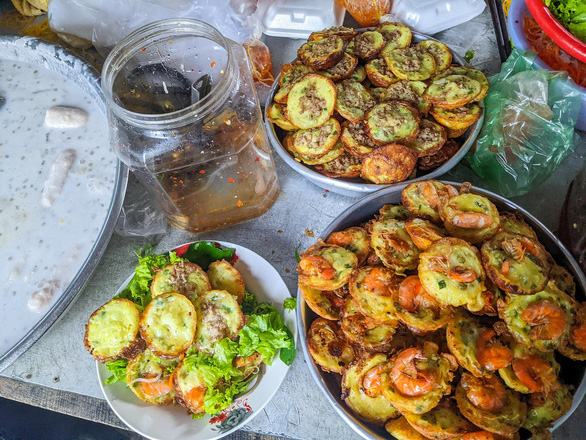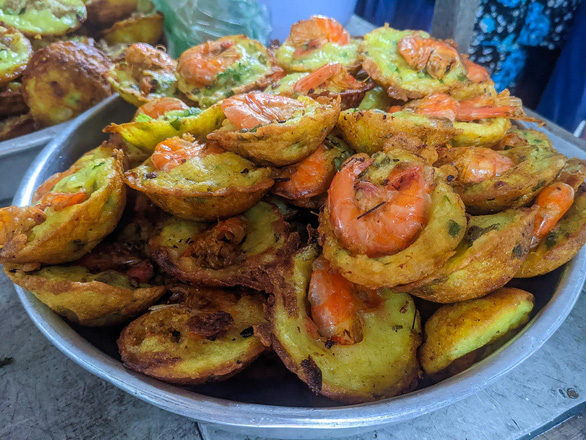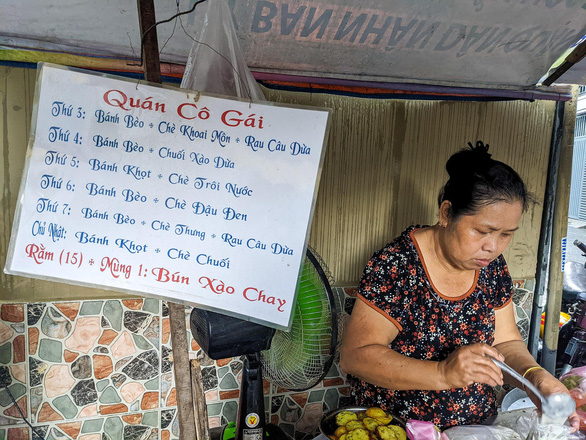For the past four decades, Co Gai, also known as Thu, has run a rustic banh khot stall in Ho Chi Minh City's Phu Nhuan District where she only opens for business on Thursday and Sunday afternoons at 2:00 pm. Her one-of-a-kind banh khot often sells out within an hour.
Banh khot, or mini savory Vietnamese pancakes, are made from cooking a mixture of rice flour, turmeric powder, and coconut milk in a cast-iron pan with prawns and mung beans.
They are typically finished off with topping specific to the region where the pancakes are made.
|
|
| Trays of fried 'banh khot' filled with prawns and minced pork at Co Gai’s stall in Phu Nhuan District, Ho Chi Minh City, Vietnam. Photo: Minh Duc / Tuoi Tre |
Despite the fact that banh khot is considered a high-fat dish, its delightful and easy-to-eat flavor profile has made it a famous part of Vietnam’s southern culinary culture.
Thu’s banh khot cart is located at 211/116 Hoang Hoa Tham Street, Ward 5, Phu Nhuan District, Ho Chi Minh City, where she opens for business each week on Thursdays and Sundays.
She also serves other local specialties and sweet desserts on the other days.
|
|
| A tray of fried 'banh khot' piled with prawns at Co Gai’s stall in Phu Nhuan District, Ho Chi Minh City, Vietnam. Photo: Minh Duc / Tuoi Tre |
Thu was born and raised in Saigon, the former name of Ho Chi Minh City still in popular use now.
She originally started her career as a trader at a market in Binh Thanh District before health issues forced her to set up a snack stall in the alley near her house.
She keeps her wares' prices low in order to retain customers.
Co Gai's banh khot is thick and shallow fried with little fat. It contains three distinct types of fillings: shrimp, minced pork, and mung beans.
Since each banh khot costs just VND3,000 (US$0.13), customers frequently purchase a kilogram of the cake to satisfy their hunger.
|
|
| Co Gai prepares 'banh khot' for customers at her stall in Phu Nhuan District, Ho Chi Minh City, Vietnam. Photo: Minh Duc / Tuoi Tre |
Co Gai's banh khot is not only affordable but also delicious and soft, allowing it to easily absorb the sweet and salty fish sauce. The fish sauce is typically adorned with fresh diced greens.
Those who like to roll the banh khot with vegetables themselves can ask Thu to leave the greens uncut.
Thu's banh khot uses banana prawn, a type of prawn with a thin shell that preserves its crispiness but is not overly hard and thick when prepared.
When eaten with a soft layer of banh khot, it creates a perfect harmony.
Like us on Facebook or follow us on Twitter to get the latest news about Vietnam!


























